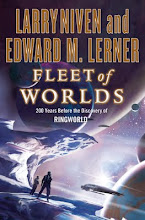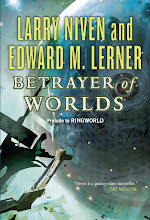How does life emerge from lifelessness? How does intelligence emerge from totally instinctive life? Science's answer to both questions has been, "don't (yet) know."
There's a business-school axiom, "If you can't measure it, you can't manage it." The scientific version is, in essence, "If you can't reproduce it, you don't understand it." Or, at least, you can't know that you understand it.
And so, synthetic biologists want to move from describing what nature has offered to building organisms from scratch. When we can build cells totally from inanimate material (and assemble DNA, not splice the good parts from living cells), then we'll know that we really understand the molecular mechanisms of life.
At least life as the DNA-centric readers of this blog know it. Because maybe we have other readers.
Thursday, October 29, 2009
Are we alone? How about now?
Posted by
Edward M. Lerner
at
5:30 PM
Labels:
AI,
biology,
ed's fiction,
first contact,
science,
science fiction,
seti,
sf
Sunday, October 25, 2009
Capclave
I spent much of last weekend at Capclave 2009. Capclave is the annual DC area SF con. I don't always make it, but this was my fifth time there.
Like the dodo logo? That's the Capclave symbol, befitting their slogan, "Where reading is not extinct!"
Capclave is a small, intimate con -- about 200 attendees in a typical year. It draws lots of local writers, including MAFIA.
Like the dodo logo? That's the Capclave symbol, befitting their slogan, "Where reading is not extinct!"
Capclave is a small, intimate con -- about 200 attendees in a typical year. It draws lots of local writers, including MAFIA.
Tuesday, October 20, 2009
Rock of ages
No one minds me calling a billion years an age, do they?
Earth, the third rock from the sun (I loved that show), is ~4.6 billion years old, the sun a bit older. (Exact estimates vary, of course.) In that time, lots has happened. The sun grew about 30% hotter (and it's not done). The Earth cooled from the heat of collapse as it coalesced out of the primordial material of the pre-solar system. Oceans and atmosphere formed. Life emerged. In time, oxygen-producing life evolved and totally changed the atmosphere.
Interesting things keep happening. Radioactive decay keeps the core hot and drives plate tectonics. Carbon-bearing rock disappears into the inter-plate subduction regions, and is returned to the atmosphere by volcanic eruptions. Continents drift, also driven by plate tectonics. There's erosion, and mountain building, and sedimentation. Ice ages come and go.
Oh yeah: early in Earth's history, a Mars-sized object smashed into our planet, melted the top many miles of Earth's surface, and blasted enough stuff into space to re-coalesce as the moon.
And on, and on.
In short, Earth is a complicated place. Geoscience, this month's theme at the Year of Science, deals with this very complex amalgam of physics, biology, and chemistry. After I harped at the non-science of recent months' YoS themes, I'm happy to see a real science recognized this month. Check it out.
And don't miss this six-minute video that introduces geoscience and has some absolutely stunning imagery. Earth is a beautiful place.
Earth, the third rock from the sun (I loved that show), is ~4.6 billion years old, the sun a bit older. (Exact estimates vary, of course.) In that time, lots has happened. The sun grew about 30% hotter (and it's not done). The Earth cooled from the heat of collapse as it coalesced out of the primordial material of the pre-solar system. Oceans and atmosphere formed. Life emerged. In time, oxygen-producing life evolved and totally changed the atmosphere.
Interesting things keep happening. Radioactive decay keeps the core hot and drives plate tectonics. Carbon-bearing rock disappears into the inter-plate subduction regions, and is returned to the atmosphere by volcanic eruptions. Continents drift, also driven by plate tectonics. There's erosion, and mountain building, and sedimentation. Ice ages come and go.
Oh yeah: early in Earth's history, a Mars-sized object smashed into our planet, melted the top many miles of Earth's surface, and blasted enough stuff into space to re-coalesce as the moon.
And on, and on.
In short, Earth is a complicated place. Geoscience, this month's theme at the Year of Science, deals with this very complex amalgam of physics, biology, and chemistry. After I harped at the non-science of recent months' YoS themes, I'm happy to see a real science recognized this month. Check it out.
And don't miss this six-minute video that introduces geoscience and has some absolutely stunning imagery. Earth is a beautiful place.
Tuesday, October 13, 2009
Small Miracles
Latest update: September 3, 2024. New editions are out in hardback, trade paperback, and ebook formats. The Audible (audio) edition remains available.
=====
My latest near-future thriller -- this time dealing with medical nanotechnology -- was released on October 13. A new book's release is always exciting, but this release is doubly noteworthy. That's because SMALL MIRACLES is this month's "SCI FI Essential" title.
 |
| Original (2009) cover |
To top off that endorsement, here are some early quotes:
Posted by
Edward M. Lerner
at
11:11 AM
Labels:
biology,
ed's fiction,
nanotech,
science fiction,
sf,
small miracles,
technothriller
Saturday, October 10, 2009
Otherwhere
For the next couple of months I'll be guest blogging at Tor.com. That's a great SFnal website, by the way ... if you haven't yet checked it out, you should. In addition to a large set of bloggers -- many names you'll surely recognize -- the site features first-rate free fiction. For example, Cory Doctorow has a long serial now running.
During my guest-blogging stint, I'll continue blogging here at SF and Nonsense -- if not necessarily as often.
During my guest-blogging stint, I'll continue blogging here at SF and Nonsense -- if not necessarily as often.
Tuesday, October 6, 2009
Not to make light of things
This morning brings news that the 2009 Nobel Prize for Physics was awarded to Charles K. Kao, Willard S. Boyle, and George E. Smith. Kao was recognized for his work with fiber-optic cables, central to modern digital networks. Boyle and Smith were recognized for their work with charge-coupled devices, the key component of digital cameras.
Well deserved recognition, of course. And yet, I'm struck by whom the Royal Swedish Academy of Sciences continues to slight: Nick Holonyak.
Well deserved recognition, of course. And yet, I'm struck by whom the Royal Swedish Academy of Sciences continues to slight: Nick Holonyak.
Thursday, October 1, 2009
Life by the numbers
I last formally studied biology in high school. (No clues will be given how long ago that was.) Lots of memorization. Little in the way of organizing principles. At the time, I didn't find it very interesting.
In recent years, though, I've been revisiting biology. It probably didn't hurt that two of my college physics buddies eventually got their PhDs in biophysics. And in the course of reintroducing myself to elements of modern biology, I recently read a book that reexamines cellular and molecular biology with tools very familiar to me as a a physicist and computer guy.
The book is An Introduction to Systems Biology: Design Principles of Biological Circuits, by Uri Alon (of the Weitzman Institute).
Circuits, you ask?
Circuits, indeed. Take the process of gene transcription: which genes in which cells are activated to express which proteins. And which cells lock into particular tissue types, and why, despite all cells in an organism having identical genetic makeup. It all happens amid lots and lots of feedback loops, because proteins (some acting as proxies for environmental factors) influence gene expression influence proteins influence ...
The fascinating theme of this textbook is: straightforward underlying principles drive this complexity.
In recent years, though, I've been revisiting biology. It probably didn't hurt that two of my college physics buddies eventually got their PhDs in biophysics. And in the course of reintroducing myself to elements of modern biology, I recently read a book that reexamines cellular and molecular biology with tools very familiar to me as a a physicist and computer guy.
The book is An Introduction to Systems Biology: Design Principles of Biological Circuits, by Uri Alon (of the Weitzman Institute).
Circuits, you ask?
Circuits, indeed. Take the process of gene transcription: which genes in which cells are activated to express which proteins. And which cells lock into particular tissue types, and why, despite all cells in an organism having identical genetic makeup. It all happens amid lots and lots of feedback loops, because proteins (some acting as proxies for environmental factors) influence gene expression influence proteins influence ...
The fascinating theme of this textbook is: straightforward underlying principles drive this complexity.
Subscribe to:
Comments (Atom)


































